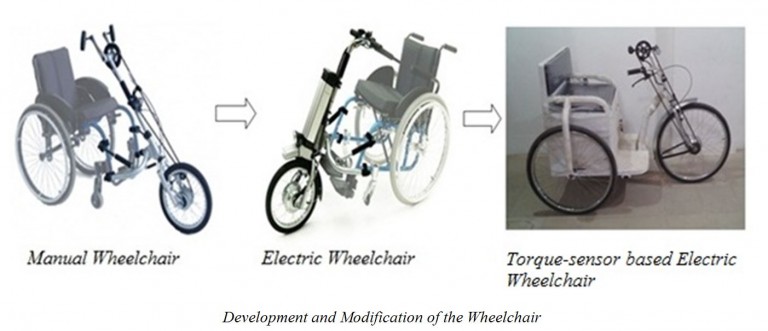Electrically Assisted Torque Sensor Based Wheelchair with Dedicated Solar Charger Kit
Millions of physically impaired people completely rely on wheelchairs for their indoor and outdoor mobility. For some developing countries, such as Bangladesh, the most available wheelchairs are driven manually by physically disabled people. Even though these three or four wheeled manual wheelchairs have emerged as blessing for them but there is no overlooking of the substantial amount of physical force that needs to be exerted by the physically handicapped people with their bare hands to turn the wheels of the manual wheelchairs [1, 2]. One of the drawbacks of using the manually driven wheelchair is that the occupant experiences severe pain and repetitive strain injury (RSI) of the upper extremities [3]. Hence, prolonged usage of the manually driven wheelchairs can cause shoulder pain and lead to musculoskeletal injury. Considering the stressful and miserable condition that are being experienced by the disabled people using traditional wheelchairs [4], the Control & Applications Research Centre (CARC)* of BRAC University has conducted a research on designing and developing a three-wheeler electric wheelchair using the throttle and torque sensor pedal along with dedicated Solar Charger Kit (SCK).
The torque sensor based electrical wheelchair consists of torque sensor module, a 250W hub motor with motor controller attached to the front wheel, three 12V sealed lead acid batteries connected in series to provide 36V to the motor and a 36V charge controller with Low Voltage Disconnect (LVD). The designed dedicated SCK consists of three solar panels with a total power of 225W (each photovoltaic panel is of 75W) connected to a 36V charge controller to charge 36V backup battery bank. The fully charged backup battery bank can be easily swapped with the discharged battery of the electric wheelchair to continue the further charging process and thus the proposed system ensures complete independence of the developed electric wheelchair from the national grid [5]. The electric wheelchair developed by the CARC is driven by 250W hub motor and the power supply to the motor from the battery bank can be controlled by a throttle system. One of the major aspects of the improved and modified electric wheelchair is introducing the torque-sensor pedal with the torque sensor module and the torque gain adjuster circuit. This new technological method applied on the proposed and developed design of the electric wheelchair enables the physically handicapped individual to drive the three-wheeler wheelchair with less human effort. To compare the performance of the designed and developed torque sensor based electric wheelchair with the traditional electric wheelchair, two field tests were conducted. At first stage, traditional throttle had been used for controlling the speed of the wheelchair and provide power to the hub motor from the battery bank and at second stage, torque sensor pedal had been used. The first field test result revealed that without implementing the torque sensor pedal, the electric wheelchair can cover a total distance of 22km in one go until the battery SOC drops down to 50%. However, after the implementation of the torque sensor pedal with the torque sensor adjustor, the result of the second field test revealed that the wheelchair can travel 43km which is almost twice. Thus, battery discharge rate is minimized upon application of human effort to pedal together with the power from the battery to run the motor and thus resulting longer distance coverage and increasing the battery life-per charge [6].
New technologies emerged and are being developed to contribute better to the community. Similarly, development of this new technology in the electrically assisted wheelchair not only helps the physically disabled people with better outdoor and indoor mobility but also allows the user to travel greater distance with the wheelchair without consuming power from the national grid. Through successful implementation of the prototype design and development of the torque-sensor based electrically assisted wheelchair, the future market expansion of this prototype electric wheelchair is expected to fulfill the vital necessity of providing a convenient mode of transport that is both environmentally and economically friendly.
*CARG SIGHT (Bangladesh) has an ongoing prototype project on the electrically assisted wheelchair which is fully funded by IEEE SIGHT, USA.


Concept for the Dedicated Solar Charger Kit (alternative to fast charging problem)
References:
[1]. “Rio Mobility Dragonfly Lightweight Handcycle for Manual Wheelchair.” Internet: http://www.wheelchairmotorcycle.com/dragonfly-handcycle , [Nov. 10, 2015].
[2]. “Firefly Electric Handcycle.” Internet: www.riomobility.com , [Nov. 09,2015]
[3]. Rory A. Cooper et al., “Heavy Handed: Repetitive Strain Injury Among Manual Wheelchair Users,” TEAMR EHA.REPORT, vol 35, Feb 1998.
[4]. Jacob P. Mullen, “Electric Wheelchairs-Helping Physically Challenged People,” Personal Training, Aug 25, 2013.
[5]. T.Faraz and A.Azad, “Solar battery charging station and torque Sensor based electrically assisted tricycle,” in IEEE Global Humanitarian Technology Conference (GHTC 2012), Seattle, WA, 2012, pp. 18-22.
[6]. AKM Abdul Malek Azad, “The Solar Assisted Rickshaw Van: A Complete Off-Grid Solution,” in IEEE Transportation Electrification Newsletter, Jan/Feb 2015, USA.
 Currently, working as a professor in the Department of Electrical and Electronic Engineering at BRAC University, Dhaka, Bangladesh, Dr. AKM Abdul Malek Azad developed an early interest in dynamic sectors of education and research work. He is also the Chairperson of Control & Applications Research Group (CARG) Bangladesh SIGHT, an IEEE USA SIGHT group in Bangladesh. From 1992 till 2006, he has worked as an academia (undertaking casual teaching) for Macquarie University, The University of New South Wales, University of Western Sydney and Institute Technology Pekerja. Dr. Azad also has worked as a Development Engineer for a biomedical engineering project (Direct Cardiac Compression device) with HEART ASSIST TECHNOLOGY Pty LTD (Australia) in collaboration with Prof. Stephen N. Hunyor, Director, Cardiac Technology Centre (CTC), Royal North Shore Hospital, North Sydney, Australia. He is a consultant (Engineering) for the World Bank Project “Productivity and Efficiency of Solar House Panels in Bangladesh: Economic, Social and Food Security Implications” associated with BIDS (Bangladesh Institute of Development Studies). He is the founder and Director of the Control & Applications Research Centre (CARC) under the Dept. of EEE, BRACU where he has also the initiator of the synergy program between BRAC and BRACU undertaking numerous research projects e.g. Solar Ambulance for BRAC HNPP, Solar Home System components testing laboratory for IDCOL, Performance analysis of BRAC Solar PV modules, etc. He is also the founder and counselor of the IEEE Student Branch at BRAC University. Because of his exemplary dedication in initiating and leading the successful IEEE volunteer-led project in Bangladesh to help solve the local electricity crisis by bringing hybrid solar rickshaw technology to the local manufacturing industry, as part of BRAC University SIGHT, he has been chosen as the 2015 recipient of the MGA Achievement Award 2015.
Currently, working as a professor in the Department of Electrical and Electronic Engineering at BRAC University, Dhaka, Bangladesh, Dr. AKM Abdul Malek Azad developed an early interest in dynamic sectors of education and research work. He is also the Chairperson of Control & Applications Research Group (CARG) Bangladesh SIGHT, an IEEE USA SIGHT group in Bangladesh. From 1992 till 2006, he has worked as an academia (undertaking casual teaching) for Macquarie University, The University of New South Wales, University of Western Sydney and Institute Technology Pekerja. Dr. Azad also has worked as a Development Engineer for a biomedical engineering project (Direct Cardiac Compression device) with HEART ASSIST TECHNOLOGY Pty LTD (Australia) in collaboration with Prof. Stephen N. Hunyor, Director, Cardiac Technology Centre (CTC), Royal North Shore Hospital, North Sydney, Australia. He is a consultant (Engineering) for the World Bank Project “Productivity and Efficiency of Solar House Panels in Bangladesh: Economic, Social and Food Security Implications” associated with BIDS (Bangladesh Institute of Development Studies). He is the founder and Director of the Control & Applications Research Centre (CARC) under the Dept. of EEE, BRACU where he has also the initiator of the synergy program between BRAC and BRACU undertaking numerous research projects e.g. Solar Ambulance for BRAC HNPP, Solar Home System components testing laboratory for IDCOL, Performance analysis of BRAC Solar PV modules, etc. He is also the founder and counselor of the IEEE Student Branch at BRAC University. Because of his exemplary dedication in initiating and leading the successful IEEE volunteer-led project in Bangladesh to help solve the local electricity crisis by bringing hybrid solar rickshaw technology to the local manufacturing industry, as part of BRAC University SIGHT, he has been chosen as the 2015 recipient of the MGA Achievement Award 2015.
About the Newsletter
Editors-in-Chief

Jin-Woo Ahn
Co-Editor-in-Chief

Sheldon Williamson
Co-Editor-in-Chief
TEC Call for Articles 2023 - Advances in Charging Systems
The TEC eNewsletter is now being indexed by Google Scholar and peer-reviewed articles are being submitted to IEEE Xplore.
To submit an article click here.


